
Click to Buy
Originally written for saxophone ensemble, Einstein on 6th Street evokes a cultural collision between the highbrow opera hall and the popular entertainment venue. At the outset of this piece, sustained notes in the baritone saxophone recall the opening progression from the iconic American opera Einstein on the Beach, written by Philip Glass and premiered nearly forty years ago on July 25, 1976. Although Glass’s opera is in four acts, its five intermezzos, also known as “Knee Plays,” are arguably the most captivating. Known for his use of repetitive motivic ideas and harmonic materials, Glass includes the counting of numbers, singing of solfeggio syllables, and speaking of prose as the lyrics in Knee Play 1. Glass incorporates these materials throughout the entire work but definitively returns to the opening mood in the opera’s final section Knee Play 5. For Montoya, these two Knee Plays supply the foundation of his sax piece, as he quotes Glass directly. Not one to merely borrow someone else’s idea, however, Montoya fuses Glass’s iconic progression together with the soundscape of his hometown, Austin, Texas, specifically the downtown area known as 6th Street. Boldly nicknamed “The Live Music Capital of the World,” Austin’s 6th Street offers the music lover live performances of varying genres such as country, metal, jazz, rap, and indie rock. On any night of the week, music fans saunter the streets, ducking in and out of bars and restaurants, going from concert to concert. Montoya mixes elements of these popular music idioms into his work, bringing Einstein into the musical mélange of the 21st century. Montoya’s piece has an ABCADAC form, and he utilizes aspects of “six” throughout, including harmonizing at the interval of a sixth below, emphasizing scale degree six, and using groupings of six notes. A master of blending materials, Montoya melds a driving eighth-note rhythm with a dotted-note syncopated groove, all while allowing melodic aspects from Glass’s Einstein to shine through, in essence offering Montoya’s own version of a Knee Play—which would appropriately be called Knee Play 6.